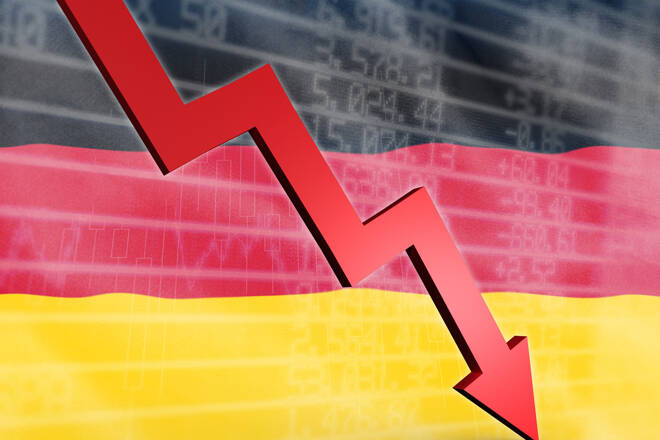Advertisement
Advertisement
European Equities: A Week in Review – 10/09/21
By:
The European majors saw red in the week, with concerns over the resilience of the economic recovery overshadowing upbeat economic data from key economies.
The Majors
It was a bearish week for the majors in the week ending 10th September. The DAX30 and the EuroStoxx600 slid by 1.09% and by 1.18% respectively. After bucking the trend in the previous week, the CAC40 saw a more modest 0.39% loss in the week.
Economic data from Germany failed to support the majors, in spite of the stats being skewed to the positive.
Concerns over the economic recovery, stemming from the spread of the Delta variant, weighed on the majors.
Economic data from China and the U.S also failed to support the majors, in spite of better-than-expected numbers.
In August, China’s U.S Dollar trade surplus widened from $56.59bn to $58.35bn, with exports up 25.6% year-on-year, and imports up 33.1%. In July, imports had been up by 28.1% and exports up by 19.3%. Economists had forecast the trade surplus to narrow from $56.59bn to $51.05bn.
The Stats
Economic data included factory orders, industrial production, and trade data from Germany.
While the stats were skewed to the positive, there was little support for the majors, with the markets looking ahead to the ECB policy decision.
ZEW Economic Sentiment figures for Germany and the Eurozone were disappointing, however, pegging the majors back.
At the end of the week, finalized inflation figures from Germany had a muted impact on the majors.
While there were plenty of stats for the markets to consider, it was ultimately the ECB monetary policy decision and press conference that was the main event.
In line with market expectations, the ECB held policy unchanged and talked of economic uncertainty stemming from the Delta variant. Lagarde did confirm plans to modestly reduce the asset purchasing program.
While supporting the majors on the day, the Thursday press conference marked the beginnings of the end to pandemic measures.
From the U.S
Early in the week, JOLT’s job openings for July were upbeat with openings rising from 10.185m to 10.943m. Economists had forecast a decline to 10.000m.
On Thursday, jobless claims were also impressive. In the week ending 3rd September initial jobless claims fell from 345k to 310k.
At the end of the week, wholesale inflation was in focus. In August, the core PPI rose by 0.6% versus a forecasted 0.5%, with the Producer Price Index rising by 0.7% versus a forecasted 0.6%. Both had risen by 1.0% in July.
The Market Movers
From the DAX, it was a bearish week for the auto sector. Volkswagen slid by 3.46%, with Continental and Daimler ending the week down by 2.84% and by 1.65% respectively. BMW saw a more modest 0.40% loss in the week.
It was a bullish week for the banking sector, however. Deutsche Bank rallied by 2.32%, with Commerzbank rising by 0.55%.
From the CAC, it was a bearish week for the banks. BNP Paribas and Credit Agricole fell by 1.95% and by 1.24% respectively, with Soc Gen ending the week down by 0.49%.
It was also a bearish week for the French auto sector. Stellantis NV and Renault slid by 2.46% and by 2.86% respectively.
Air France-KLM fell by a further 3.39%, with Airbus ending the week with a 0.1% loss.
On the VIX Index
It was a 2nd consecutive week in the green for the VIX in the week ending 10th September.
Following an 0.12% rise from the previous week, the VIX jumped by 27.67% to end the week at 20.95.
3-days in the green from 4 sessions, which included a 11.44% rise on Friday delivered the upside.
For the week, the Dow slid by 2.15%, with the NASDAQ and the S&P500 falling by 1.61% and by 1.69% respectively.
The Week Ahead
It’s a relatively busy week ahead on the economic calendar.
Key stats include industrial production and trade data for the Eurozone, the numbers due out on Wednesday and Thursday.
Finalized inflation figures for member states and the Eurozone are also due out in the week.
Barring any marked revisions from prelim figures, expect the Eurozone’s numbers to have a greater influence.
From the U.S, it’s a busy week ahead, with inflation and industrial production in focus early in the week.
On Thursday, retail sales and jobless claims figures will also have a material impact on market risk sentiment.
Consumer sentiment figures for September wraps things up on Friday.
We can also expect economic data from China to influence in the week.
Industrial production, fixed asset investment, and retail sales figures will be in focus on Wednesday.
Away from the economic calendar, expect COVID-19 news updates and central bank chatter to also influence.
About the Author
Bob Masonauthor
With over 28 years of experience in the financial industry, Bob has worked with various global rating agencies and multinational banks. Currently he is covering currencies, commodities, alternative asset classes and global equities, focusing mostly on European and Asian markets.
Advertisement
